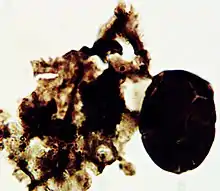Palaeoglomus
Palaeoglomus ("ancient ball") is a genus of microscopic mycorrhizal fossil, found in palynological preparations of rocks which separate out organic remains by acid dissolution.
| Palaeoglomus | |
|---|---|
 | |
| Spore and arbuscle of Palaeoglomus strotheri, from Douglas Lake Member of Lenoir Limestone, at Douglas Dam, Tennessee[1] | |
| Scientific classification | |
| Kingdom: | |
| Division: | |
| Class: | |
| Family: | |
| Genus: | Palaeoglomus Redecker et al. (2002)[2] |
| Type species | |
| Palaeoglomus grayi Redecker et al. (2002) | |
Description
Palaeoglomus has large spherical to ellipsoidal spores with multilayered walls, as well as irregularly shaped vesicles, attached to aseptate hyphae.
Species
Palaeoglomus grayi type species from the Middle Ordovician Guttenberg Formation near Platteville, Wisconsin.[2]
Palaeoglomus boullardi from the Early Devonian Rhynie Chert bear Rhynie, Scotland.[3]
Palaeoglomus strotheri from the Middle Ordovician (Darriwilian, 460 million years old) Douglas Lake Member of the Lenoir Limestone from Douglas Dam, Tennessee.[1]
Biological affinities
Palaeoglomus is similar to modern mycorrhizae such as Glomus.
References
- Retallack, G.J. (2019). "Ordovician land plants and fungi from Douglas Dam, Tennessee". The Palaeobotanist. 68: 1–33.
- Redecker, D.; Kodner,R.; Graham, L.E. (2002). "Palaeoglomus grayi from the Ordovician". Mycotaxon. 84: 33–37.
- Strullu-Derrien, C.; Kenrick,P.; Pressel,S.; Duckett, J.G.; Rioult, J.P.; Strullu,D.G. (2014). "Fungal associations in Horneophyton ligneri from the Rhynie Chert (c. 407 million year old) closely resemble those in extant lower land plants: novel insights into ancestral plant–fungus symbioses". New Phytologist. 203 (3): 964–9797. doi:10.1111/nph.12805. PMID 24750009.
This article is issued from Wikipedia. The text is licensed under Creative Commons - Attribution - Sharealike. Additional terms may apply for the media files.